|
In
the 11th and 12th centuries CE, the kingdoms bordering
the frontiers of Medieval India faced a series of
assaults from the Ghaznavid and Turkish Armies. At that
time these kingdoms had resources that were far more
superior then these of the Muslim armies of Central Asia
that were challenging their borders. The Indian warriors
of Medieval Ages had made a name for themselves in valor
and courage and they were in no way inferior to their
enemies in might. And yet their armies were unable to
face the onslaught of the Muslim armies that came from
overseas and others from land crossing the passes of
Hindu Kush Mountain Range. Modern historians are
puzzled about how a small army of Muslim soldiers could
penetrate so deep into the heart of Medieval India even
to this day!
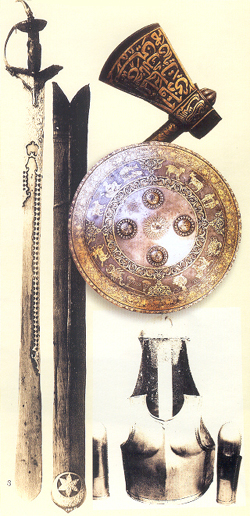
If we study this subject
objectively, we find that the Muslim armies came fully
equipped with cavalries on horses, complete with saddles
and stirrups. The soldiers wore full body armor made of
thick metal, helmets made of chain mail and plate armor
capable of withstanding any physical attack against
their bodies by their opponents. They carried with them
sharp, curved swords and daggers that were made of a
superior alloy of iron, which was very similar to steel,
and that was capable of cutting deep into the armor and
bodies of their adversaries. Moreover, they had
introduced the use of gunpowder fired from cannons that
made a loud noise and flashed fire that disoriented the
elephants and horses in the armies of the kingdoms of
India. That prevented the Indians from forming
strategies and to counter attacks against them, or lead
organized cavalry charges to meet the threat.
The Turkish
Muslim armies had acquired sophistication to use bows
and arrows and their bows had over the years evolved
into a formidable weapon that could fire an arrow with
deadly accuracy. Each archer mounted in a cavalry unit
formed an invaluable unit of the army, which was capable
of inflicting maximum damage. According to the
historical sources, it was Muhammad bin Qasim - a
general deputed by the Caliph -who first attacked Sindh
in the year 711 CE to rescue Muslims taken hostages by
its ruler from their sailing vessels on high seas. The
Arab armies that accompanied him fired the town with
catapults and arrows, ignited with fire by the use of
Naphtha, and succeeded in creating havoc and
confusion in the Sindh armies. The Muslims had perfected
the use of bow as a tool of precision in archery and
their skills were unmatched by any other army in those
days.
The bows and
arrows continued to be the weapons of war of the Muslim
armies until the end of the Mughal rule, and as a rule
the man-made bows were four feet long and generally
shaped into a double curve. The arrows were carried in
quivers, which were known as Tarkash, and the
bows in a case called as the Qirban or Jaibah.
The bows and the arrows were transported on the backs of
animals in a casing that was called Saghdaq. The
bow makers had learnt the art of bow making in the
weapon centers of Damascus and the most famous of them
were entrusted with the task of manufacturing bows and
arrows for the Muslim armies.
Although the
Mughal armies used firearms and battle cannons in all
their expeditions in India, the use of sword continued
to be an important weapon of offense against the enemy
soldiers. Great importance was given to attaining
mastery in its use and the soldier who wielded the sword
expertly was awarded with a rank of distinction. The
Mughal Emperor Akbar had in his personal collection
about thirty swords that were meant for his use during
times of war. The Nihang Nama, a seventeenth
century illustrated manuscript lists all the types of
swords used in India by the Mughal armies according to
their ranks and names.
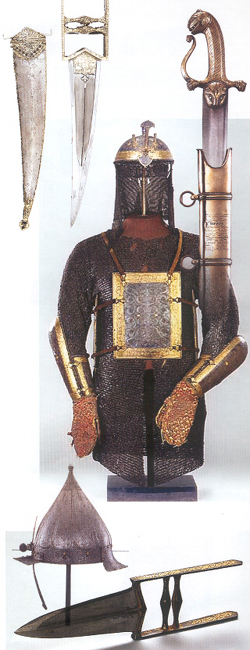
The swords used
in the Northern Indian Kingdoms before the Muslim rule
were the straight swords with rounded points or the
curved sword, which made a thrusting blow impossible.
They were heavy and after the advent of Muslim rule, the
heavy straight swords of the Indian armies evolved into
a curved, slender blade made after the fashion of
Islamic swords the curvature of which fitted neatly into
the belly of a horse of mounted cavalry soldiers. The
finest and the most praised among the swords was the
Shamsher, which was used as a cutting weapon with a
perfect curve that reached India brought for the first
time from Persia. The immense value of this Central
Asian Saber developed into a new shape, which was called
Khanda by the Rajputs and the early Muslim
Emperors.
The Muslim armies
also wore in their belts daggers with curved blades with
cutting edges on both sides as a secondary weapon. Most
of the other daggers had a single cutting edge, and they
were used during the times of war and for peaceful
purposes. This short dagger, sometimes worn in the
horsemanís boot or khuff was known as Jamadhar,
which was a weapon that the Muslims borrowed from the
Hindus.
During the Mughal
rule the sword makers experimented with inventing
variants of the existing swords. Some of them were the
curved-bladed Jambia, the straight-bladed Kard,
the leaf-bladed Katar, the slightly curved
double-edged Khanjar and the pointed single-edged
blade called Peshqabz. Its hilts were usually
decorated with jewels, metal or jade in the shapes of
different animals.
Other popular
weapon used by the Muslim armies was the Bhala or
the spear that was carried by both, mounted cavalry
soldiers and the infantry. It was made of bamboo, wood,
or cane, which were fitted neatly into sharp metallic
spear heads and it became the most reliable weapons of
the Medieval Muslim armies in India from the eleventh to
the fourteenth century CE.
Other weapons the
Muslim armies were equipped with were maces (Gada),
which had a globular head with a handle and a knob at
its end, Piyazi, shaped after an onion and
Garguz, fashioned after the likes of an eight-petal
flower. Shapshar with an oval shaped head and
Amud with a simple rounded head were primarily
weapons used by them to break the helmets and armor worn
by the enemy soldiers.
War-axes (Tabar),
which were double-edged or single-edged weapons were the
favorite weapons of some of the units of infantry.
Another favorite weapon was a narrow-bladed axe with a
spike attached to its back that was used as an
armor-piercing weapon (Jaghnol). Its use was
widely popularized by the Ghurid armies and was later
fashioned by the Rajputs into an advanced war weapon.
The war-axe was the favorite weapon of Nadir Shah who
invaded Delhi in 1739 CE and it is still preserved in
the National Museum of Delhi. It has inscriptions in
Persian Calligraphy, which shows that it was made
especially for the use of the king and its handle
ornamented with superb metalwork of silver and gold.
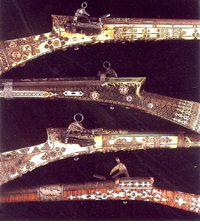
A great deal of
attention was paid to perfect the body armor of the
Muslim soldiers. Scale armor commonly worn by Muslim
soldiers for their protection was extremely popular and
its variant the lamellar armor (Jashwan) was
carried to India by the Muslims from Central Asia after
passing through Persia. The body armor was known by its
general name Bukhtar. Another type of armor was
the Angirkha that was used as an armor vest and
worn under the coat, as well as the Jama -a long
coat, worn over this armor to make it invisible. This
was mainly used for the protection of the royal family.
The Char-aina (four-mirrored) armor made of four
plates, which protected the body from the front and the
back and also from the two sides was the personal
favorite armors of Mughal Emperors Humayun and Aurangzeb.
The headgear of this armor was in the form of a helmet
and chain mail, which enabled the combatant to see his
enemy clearly, while fighting him. This type of armor,
usually worn by the elite and the royal personages in
the army was expensive and was used only by the
privileged leaders.
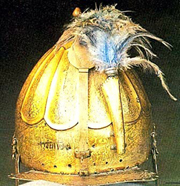
Shields for the
Muslim armies were made of wood, cane or bamboo, and
some of them were covered with variety of animal hides,
like ox, buffalo and Sambhar (deer). The shields
made from the skin of rhinoceros were highly prized, as
it was light, durable and handy during a battle.
Sometimes even the skins of tortoise and crocodiles were
used in making shields. The wood shields covered with
leather was known as Juna, and those made only
from cane and bamboos were called as Pahri.
Shields made of iron-steel were known as Sipar.
Another shield by name Tilwa was used only in
tournaments. The metal shield, which was favored and
used personally by Emperor Akbar in battlefields, had
twelve signs of the Zodiac carved on it. The people
employed for making shields for the army were known as
Dhabdar.
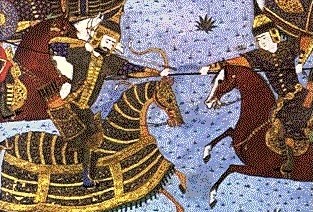
The knights of
the Muslim armies took great care for the safety of
their animals, as they were needed for maneuvering,
while fighting an enemy combatant. Turkish horses were
highly prized and they were led into the battlefield
fully clad in armor that was especially made for them. A
metal plate, known as Qashqa, was molded in the
form of a plate that would completely protected the head
of the horse from any sword blows directed against the
animal.
Elephants were
also led into the battlefield fully equipped with armor.
The armor made to protect the vulnerable trunk and the
forehead of the elephant was known as Pakhar. A
metal goad called Ankush was used to control
elephants in the course of a battle.
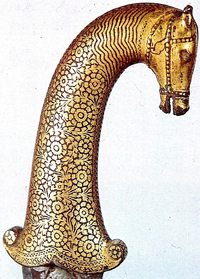
In general, great
care was taken while preparing arms for the Muslim
soldiers and their animals, which significantly
contributed to their successes.
The swords and
the body armor started falling out of trend at the end
of Mughal rule, with the arrival of improved firearms on
the scene, which were much more effective. The use of
swords and armor gradually disappeared from the memory
of people and there is little that is known about them
except what is preserved in the museums in different
parts of the world and the scraps of literature written
about them, which are now preserved in the archives of
the libraries. | 